Welcome, spring semester
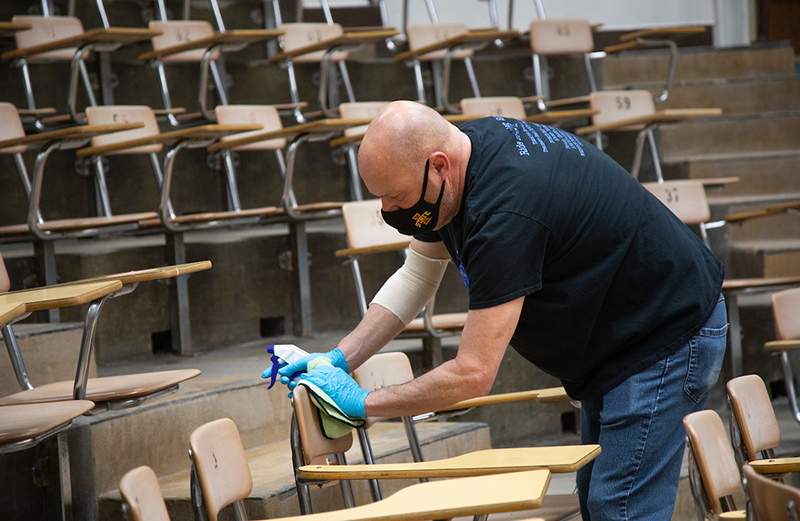
Photos by Matt Van Winkle.
Dean Redix (above) and Karen Carlson (below), members of the custodial team assigned to Gilman Hall, were cleaning and disinfecting desks and chairs in classrooms this week prior to the start of spring classes on Monday. With lighter use of the building this fall due to the pandemic -- and particularly in the last seven weeks -- team members said they used the time for deep cleaning and special projects such as carpet cleaning and wall washing. When classes begin, classrooms, restrooms and high-touch surfaces in the public spaces of academic buildings will be disinfected daily.
Carlson, a 35-year university employee who will retire this summer, called her final year at Iowa State "the most bizarre year I've had here."
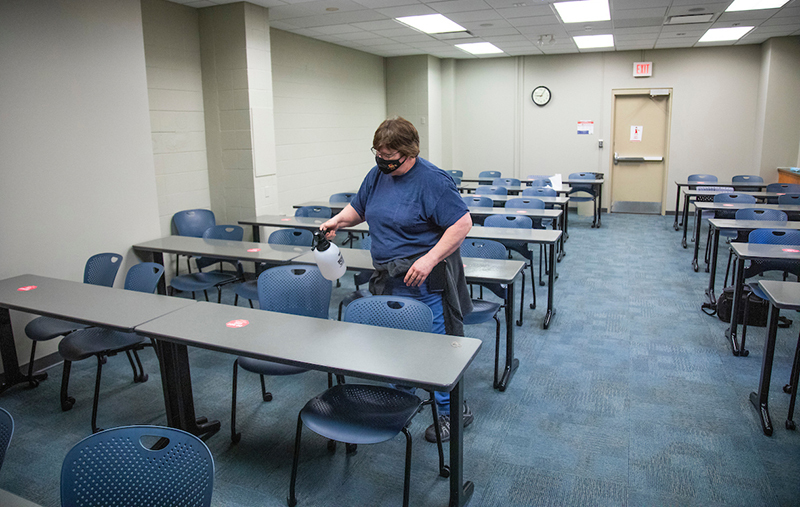
Patience is crucial as campus awaits wider distribution of vaccine
The innovative vaccines approved to protect against COVID-19 are safe and effective but unfortunately still relatively scarce, leaving the timeline for campuswide availability out of the university's control, an ISU panel of health experts said in a Jan. 15 town hall.
ISU vaccine website
Iowa State has created a vaccine page on its main COVID-19 website for sharing updates and information about vaccines, including links to state and federal resources.
Distribution of the vaccines in the U.S. begins with the federal government allocating supplies to states, which set their own policies and procedures for delivering doses to their residents. In Iowa, the Iowa Department of Public Health (IDPH) establishes how to prioritize which populations to vaccinate and works with county health departments to distribute to health providers approved to administer the vaccine, such as the Thielen Student Health Center.
"It's not Iowa State making our own plan. It's not Story County making its own independent plan. We're part of an overall phasing process," said Erin Baldwin, associate vice president for student health and wellness.
The state's first phase of vaccine distribution covered staff and residents at long-term care facilities and health care staff, allowing ISU employees who work at the health center or the COVID-19 testing site to be vaccinated. Decisions on who to include in subsequent IDPH vaccine rollout phases are in flux, adjusted as vaccine supply expectations change and new considerations emerge.
Iowa vaccine status
IDPH shares current information about vaccine distribution in Iowa in an online report. As of Jan. 19, 156,296 doses had been administered in the state and 16,854 people had received both doses. In Story County, vaccine providers had administered 6,140 doses and 965 people had received both doses.
For instance, Baldwin said, IDPH made several changes in the past few weeks to the state's second phase set to begin Feb. 1. Current plans for phase 1B include people older than 64 and those in numerous specified living situations or occupations -- such as staff at Pre-K-12 schools but not colleges.
"I think the biggest takeaway today is to understand the vaccine rollout phases are constantly changing and that Iowa State is part of a chain of command. It's also important to understand that vaccine plans are going to look different from state to state, and the phasing will look different," she said. "We just have to know that things will continue to change, and we'll provide information as soon as it's available."
Uncertainty about the coming phases and the amount of vaccine Iowa and Story County will receive makes it impossible to estimate when particular groups or individuals on campus will have access to the vaccine, Baldwin said. Wide distribution likely is several months away. In the meantime, she recommended taking advantage of any offer to be vaccinated, though it's important to be wary of possible scams.
"If you have an opportunity to get your vaccine through your health provider, we want you to take that opportunity. We encourage you to get the vaccine wherever you can," she said.
Vaccine of the future
The vaccines approved so far for use in the U.S. were developed by Moderna and Pfizer-BioNTech and both rely on an injection of genetic material, mRNA, to direct cells to make the protein that forms the spikes on the outer surface of the virus that causes COVID-19. The spike protein the body makes acts as a harmless decoy, triggering a flood of antibodies to fend off the actual virus. These are the first vaccines ever approved for human use that employ the mRNA method.
Though they're the first, they won't be the last. ISU vaccine expert David Verhoeven, an assistant professor of veterinary microbiology and preventive medicine, said vaccines that use mRNA are likely the vaccines of the future because they work well and are easy to create. The Moderna vaccine was designed in two days, he said.
"That could be very important when we have some of these variants people are starting to hear about," he said.
Despite the rapid development, the vaccines went through a full approval process and data from their large-scale trials shows few adverse reactions. Both are more than 90% effective, far better than the 50% protection many expected, Verhoeven said.
"They knocked it out of the park," he said.
The vaccines require an injection into the shoulder, and then a booster dose administered a few weeks later. It's not yet clear how long the protection will last, but it appears to be stronger than the immunity provided by having had COVID-19, said Dan Fulton, an infectious disease specialist at McFarland Clinic in Ames. Annual booster shots might be needed to maintain immunity, Verhoeven said.
Taking the leap
While an mRNA vaccine uses genetic material, it doesn't interact with your DNA and poses no risk of causing cellular changes, Verhoeven said. There's also no risk of the vaccine causing COVID-19, Fulton said.
"People do not get coronavirus from the vaccine," Fulton said. "It's just not possible."
Still, it's normal for people to have concerns about the safety of a new vaccine, Fulton said, noting that his grandparents had to consider a similar plunge into the unknown in the 1950s when deciding whether their children should take the newly developed polio vaccine. He encouraged those unsure about taking the vaccine to consult reliable sources of information and said those looking to persuade the reluctant should try to dispel myths with facts and share their own values and experiences.
"This is something that people have encountered before, and it does take a fair amount of courage to move forward. But when you do, it can have a profound impact," he said.
For viral infections, prevention typically trumps treatment and vaccines are often the best method of prevention, Fulton said. He expects the vaccines will be approved for use in children in the near future -- both manufacturers are running juvenile trials -- and he would not oppose vaccinating pregnant or breastfeeding women.
"For the grand, grand majority of people, this is a useful tool I'd recommend," he said.
After the shot
Though the vaccines may pave the way for a return to pre-pandemic life, it won't happen quickly. The Cyclones Care practices in place on campus throughout the summer and fall -- including face coverings and physical distancing -- will continue in the spring semester. The university’s testing, case investigation and contact tracing programs remain essential.
"It is critically important we remain vigilant and diligent," President Wendy Wintersteen said in introducing the town hall panel.
Even people who have been vaccinated should continue mitigation steps such as wearing face coverings and maintaining distance from others, as some studies have shown that people with COVID-19 immunity may still carry the virus in their nasal passages, Verhoeven said.
"Some individuals might be able to shed that virus," he said.
It will probably take 70-80% of people being immunized to achieve the herd immunity needed to prevent community spread, a level that depends on vaccination rates and durability, the contagiousness of coronavirus variants and other unknown factors, Fulton said. Hitting that mark is a long way off, said Kristen Obbink, COVID-19 public health coordinator.
"The vaccine provides hope, but the virus is still here in our community," she said.
Testing remains key piece of COVID-19 mitigation plan
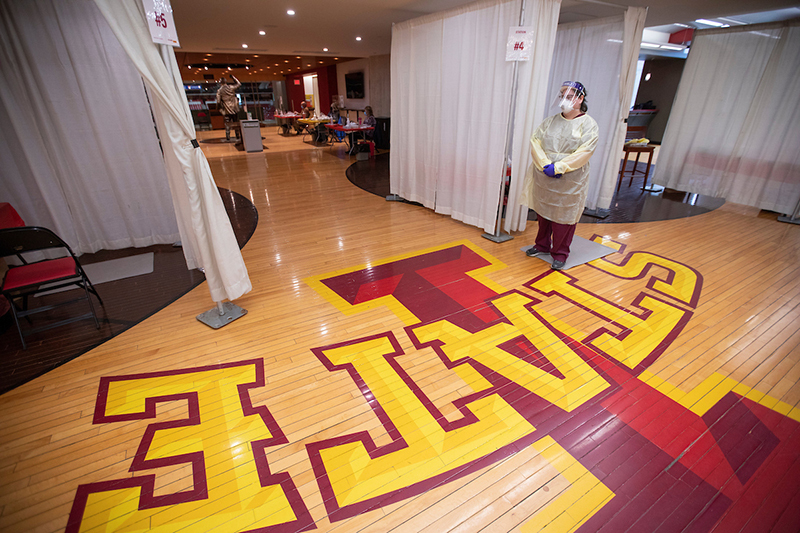
COVID-19 testing for students, staff and faculty showing symptoms continues in Johnny's at Hilton Coliseum this semester. File photo by Christopher Gannon.
Interest in COVID-19 vaccines is keen right now, but Iowa State also will continue its testing operation as a mitigation strategy during spring semester.
Headquartered at Thielen Student Health Center during the winter break, the COVID-19 testing site reopened at Johnny's in Hilton Coliseum Jan. 11, buffeted with a new staffing plan. Students, faculty and staff experiencing COVID-19 symptoms have access to testing six days a week: 8 a.m.-4 p.m. Monday, Tuesday, Thursday and Friday; 10 a.m.-4 p.m. Wednesday; and 9 a.m.-noon Saturday. To schedule a COVID-19 test, call 515-294-5801 (option 9) or schedule online at cyclonehealth.org/appt. Individuals also need to complete a pretest questionnaire to help determine whether they need to be tested.
By the numbers
Eight slides capture campus efforts last fall to manage the pandemic
Any member of the university community who gets tested off campus should report their results to Iowa State.
The Thielen center will administer COVID-19 tests to ISU students who show symptoms while at the clinic for another purpose.
Testing plans for student move in
As it did in August, the university is requiring COVID-19 testing for new-to-the-residence-system students before they receive their room or apartment keys. They may be tested on campus when they first arrive, or these students can fulfill this requirement by showing the results of a negative COVID-19 test that's less than 72 hours old or a positive test within the past 90 days. Students who test positive will need to isolate for 10 days.
Additionally, the university is requiring COVID-19 testing during the Jan. 11-29 window for a random sampling of approximately 5,000 students who live in a residence hall or are members of a sorority or fraternity.
A statistics faculty team -- first tapped last summer to project the positive test rate during August student move in -- developed the random sampling model being used. Sampling is weighted based on the positivity rate in the county of each student's home zip code to increase the probability that students coming from areas with higher infection rates will be selected in the sample. Student names are not included in any of the data.
In their Jan. 11 memo to the campus community, associate vice president for student health and wellness Erin Baldwin and COVID-19 public health coordinator Kristen Obbink said additional efforts to test asymptomatic individuals this semester will be based on campus trends and needs.
Asymptomatic testing for employees
On Jan. 8, Iowa State participated in a larger test of asymptomatic adults offered through a collaboration between Johnston-based Corteva Agriscience and the Bill and Melinda Gates Foundation. Three campus testing sites were open, at no charge, to asymptomatic adults in Story County. A total of 939 tests were collected, about 60% of which were individuals affiliated with the university. Nineteen of the 577 ISU tests were positive for COVID-19, a positivity rate of 3.3%.
Cyclones still care
The university's Cyclones Care behavior campaign launched last summer remains in place for spring semester. Students, faculty and staff can help prevent the spread of COVID-19 with these four practices:
- Wear a face covering
- Stay physically distanced from others
- Wash or sanitize hands often
- Stay home when ill
The behaviors are important everywhere: in the office, classroom or library, on CyRide, in the Ames community and at home.
Forum provides tips for managing pandemic emotions
Living life during a pandemic has forced many people to deal with significant disruptions to their daily lives and handle the overwhelming emotions that come with it.
To help ISU employees find ways to deal with the pandemic’s psychological toll, ISU WorkLife and university human resources sponsored the forum, Above the Emotional Fray: Managing Your Emotions Through Pandemic Fatigue on Jan. 19.
ISU WellBeing
A recording of the forum will be available on the WorkLife website under the "Special Events" tab. For more information on mental health resources as well as mindfulness and well-being activities go to the ISU WellBeing website.
More than 200 people registered for the virtual event where five panelists -- Luke Seaward, expert in stress management; Dina Eisenberg, ISU ombuds officer; Jacob Meyer, ISU assistant professor of kinesiology; Doug Gentile, ISU professor of psychology; and Joleen Frideres, licensed mental health counselor -- answered questions posed by moderator Stephanie Downs, ISU WorkLife and WellBeing senior coordinator.
What to question
Gentile said it's too late to question whether the pandemic has eroded the quality of my life; it probably has. Two more useful questions at this point, he said, are:
- Are the coping strategies and habits I have developed still helping me or hurting me?
- What supports do I need to change the habits or build new healthier ones?
Ways to find balance
Looking at only the negative leads to stress, but it is unrealistic to only see the positive. Panelists shared ideas for finding a healthy balance:
- Look for one positive when times are challenging
- Spend more time outside
- Take a walk before and/or after work to reset
- Reduce screen time and avoid "doom scrolling"
- Regularity of exercise trumps duration and intensity
- Do something nice for another person
- Make a list of things you can and cannot control; focus on what you can
- Meditate
Dealing with stress
Much of the past 10 months has people grieving the loss of the way things used to be. Seaward acknowledged the importance of grieving but warned not to get stuck in it.
"There is healthy grieving, but we don't want to get so caught up in it that it is all we do," he said. "Prolonged grieving becomes a stressor in itself and leads to health problems."
The key is to acknowledge it, address it and move beyond it. Be a victor and not a victim when it comes to dealing with stress, Seaward said.
Meyer's research on activity and well-being during this time led to what he called predictable but important conclusions:
- People who decreased their activity level in response to the pandemic had higher levels of depression and anxiety than people who maintained their activity level.
- People who increased screen time experienced more loneliness, depression and stress.
- People who maintained or increased time spent outside during the pandemic had lower levels of stress and better mental health.
Asking for help
Eisenberg said the challenges of the pandemic have led to many questioning their own ability to trust.
"No one is fine right now," she said. "If someone says they are, they are lying to themselves and to you. No one is getting through this challenging time without some struggle."
Working from home can make it difficult to know when or who to reach out to for support and help. Voicing struggles is important because it allows others to feel comfortable sharing their feelings, Eisenberg said.
Eisenberg suggests people check in with themselves throughout the day and do something to reset -- take a 20-minute nap, if needed.
Being able to overcome one's own ego and show some vulnerability is key to getting help from others, Frideres said.
Dealing with anger
Not being in control -- of a situation or how others respond to it -- has some feeling angry, Eisenberg said.
"Anger is not necessarily a bad emotion, but what you do with it could be bad," she said. "Often the target is not what we are angry about, it is just nearest or easiest to hit."
Taking a moment to pause allows for a chance to think about what led to the emotion and how it can be channeled.
Anger is a protective emotion but often masks fear or hurt, Frideres said.
"Anger is a healthy emotion because it is a survival emotion," Seaward said. "It is OK to be angry, but you want to refine your expectations so you don't give your power away."
The little things make faculty mentoring program stand out
Whether it is a moment or a lifetime, mentoring is not just something between instructor and student. It is just as important between faculty members.
Mentoring can take on many forms at Iowa State, but the formal mentoring program pairs new tenure-eligible faculty with senior colleagues, typically from the same department. Its duration varies, but focus is put on the tenure process leading up to the third-year review.
"It is critical to our mission of creating, sharing and applying knowledge," assistant provost for faculty development Tera Jordan said. "We frequently think of that in the context of students, but it relates to our core mission and faculty development. It helps ensure our campus is open and accessible to all."
January is National Mentoring Month, but Jordan said mentoring is something the university is constantly evaluating. Opening other pathways for term and tenured faculty is being discussed by university leaders to bring mentoring full circle.
"We are working to bring more consistency across the campus community related to availability of mentors as well as identifying a mentor," Jordan said. "We have focused on mentors in your department or definitely in your college, but I would like to expand that lens if we can to connect with other people not always in your discipline that could benefit from a mentoring relationship."
Succeeding in a different model
Mentoring has an important role in the College of Veterinary Medicine for Derald Holtkamp, professor in veterinary diagnostic and production animal medicine.
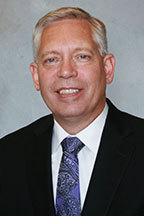
Holtkamp
"We often don't have the typical model of faculty members who get a Ph.D., immediately take a job in academia and spend their career there," he said. "Most of them have some experience in the private sector, and as a consequence, how we are evaluated for promotion or tenure relies more on the impact we can have on the industry rather than our number of publications."
A less formal structure means the need for strong mentor-mentee relationships that build institutional knowledge.
Holtkamp, a 2020 Exemplary Faculty Mentor Award winner, had his own positive experience as a mentee when he joined the university in 2006. It was then he learned how little efforts can make the biggest difference.
"The most useful things came out of the informal interactions," he said. "It may be a specific problem or question I was trying to figure out, and I would reach out to them and those were the most fruitful."
Finding common research interests can build a foundation and fill in gaps with issues that may otherwise go overlooked such as filling out forms or grant proposals.
"It can be very helpful to hear from a mentor what needs to be done to be promoted and achieve tenure," he said. "There is always a lot of room for interpretation ... so it is nice to have a faculty member provide advice and guidance."
Holtkamp sees mentoring as a chance to build community in a department, college or the university while simultaneously strengthening the faculty.
Helping one benefits all
Associate professor in supply chain management Haozhe Chen views mentoring as not only key to an individual's success, but a group’s. It is something the Ivy College of Business takes seriously, assigning a mentor to each faculty member who joins the college.
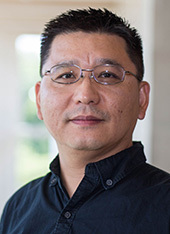
Chen
"It is a very important element in developing a supportive culture," Chen said. "I would say it is something we definitely have in our department. It is often the daily interactions with colleagues that are most helpful."
Chen -- who received the faculty mentor award in 2019 -- credits his department's openness and willingness to help one another for making it a place where faculty can succeed. It also keeps the goals of a department or college aligned, he said.
Chen came to ISU from another university and benefited most from help that went beyond procedures of trying to attain tenure or how best to put together and deliver a course.
"It was the things that were not so tangible," he said. "It was the small things that helped me settle into a new environment, and learn how to get up and running as quickly as possible."
Chen stresses those tips and small pieces of advice with his mentees, favoring an informal approach.
Chen believes he can get as much out of interactions with new faculty as they can.
"Every person comes from a different background and has a different experience, so by working with them I am exposed to new ideas and practices," he said.
The big picture
Newer faculty have plenty on their plate, and School of Education professor Connie Hargrave feels she can best assist them by keeping things in perspective.
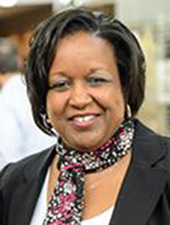
Hargrave
"Having somebody who could see the big picture even though I was caught up in the details or specifics has always been very helpful," said the 2020 faculty mentor award recipient. "Someone with more experience can see what you are trying to do and how it needs to be situated in a larger context."
Having a mentor early on helps answer the not so obvious questions nearly everyone has when beginning a job, but also it shows the commitment the university makes to its faculty, Hargrave said. Finding a mentor outside of one's discipline can help faculty realize there is a larger world on campus than just their department and how their work fits in, she said.
"When a university makes that kind of investment and continues to grow that investment, it says how important faculty are and how important faculty success is to the university," Hargrave said.
Keeping interactions and suggestions frank and practical is something Hargrave does with her mentees.
"I try to help people remember their own humanity and the humanity of their students," she said.
Hargrave has many unofficial mentors that have turned into friends over the years who find different ways to support and motivate each other as the relationship evolves. The need for a mentor may change, but their impact is often felt long after the work is done, she said.
